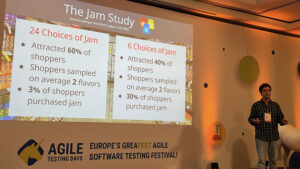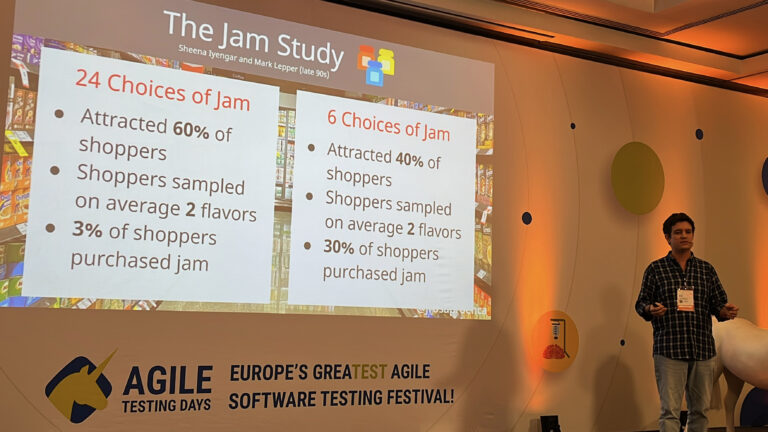This is my second post to share some of my big “aha moments” at Agile Testing Days. João Proença’s keynote really opened my eyes and explained a lot of what I have experienced, but not really understood!
I’ve found techniques such as risk storming and time-boxed exploratory testing charters to be reliably effective. I hadn’t thought about the science behind that effectiveness. One huge “aha moment” for me at Agile Testing Days was learning about that science from João Proença’s “Limitless within our boundaries” keynote.
João’s was the second keynote to start off with a story involving guitars! He recounted how he and his friends put together a successful garage band on a shoestring, improvising instruments and amplification. They were getting better gigs and eventually a recording opportunity. Yet in the well-equipped studio, they lost their mojo and failed to record anything. What a mystery – or perhaps not!

Enter the jam study. Unsurprisingly, we humans love choices – the more we have, the happier we feel. Except… with too many choices, we lose our decision-making power. As João pointed out, many of us experience this when we look for what to watch on Netflix – I know I end up scrolling around for at least 20 minutes. Lots different from when we had three channels to choose from in pre-cable days. Many choices leads to FOMO, escalated expectations, misery, and a band choking – and yet we still want all those options!
João shared some great examples of the down side of more choices, from Obama’s suits to George Lucas’ Star Wars technology and budgets. You can see some of these on my live Twitter feed of the keynote. We fall victim to this in so many ways as we build software products. Look at my fancy architecture! I want to keep all my options open! As I learned more during this talk, I reflected that this is one reason Extreme Programming works so well. One of its mantras is, “Do the simplest thing that could possibly work”. Building in tiny increments in quick iterations limits our range of choices. It lets us learn from fast failure, and as João reminded us, we shouldn’t fear learning from failure.
I have long been a fan of time-boxed exploratory testing charters, following Elisabeth Hendrickson’s template. They help my team focus on a specific slice of learning about the feature we’re testing, and make our testing time more predictable. Thanks to João, now I get why imposing some constraints helps us. Similarly, with risk storming, having to choose only a small number of risk areas means that we use our time on mitigating the most important ones.
I’ve often heard over the years that constraints make us more creative. Limiting ourselves to using four colors for a painting, giving a child only some boxes to play with, constraints help our brains think laterally. João emphasized how remote working gives us even more choices, and reminded us that we really need to focus on the priorities in our lives. He inspired me with his words, “How will the paradox of choice affect us? Constraints allow us to be limitless!”


